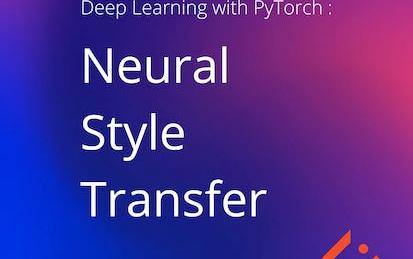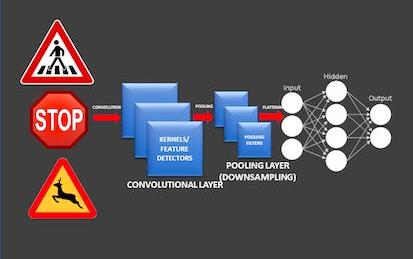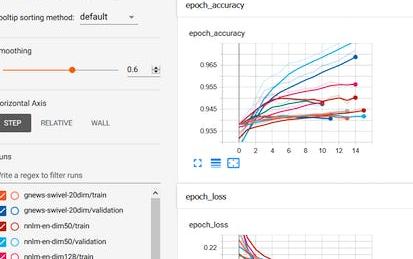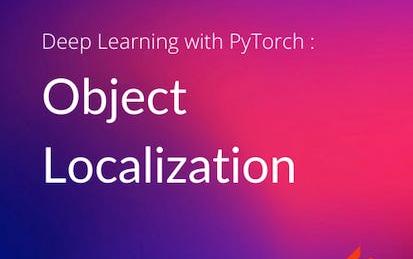

Our Courses

Deep Learning with PyTorch : Neural Style Transfer
In this 2 hour-long project-based course, you will learn to implement neural style transfer using PyTorch.
-
Course by

-
 Self Paced
Self Paced
-
 4 hours
4 hours
-
 English
English

PyTorch Basics for Machine Learning
This course is the first part in a two part course and will teach you the fundamentals of PyTorch. In this course you will implement classic machine learning algorithms, focusing on how PyTorch creates and optimizes models. You will quickly iterate through different aspects of PyTorch giving you strong foundations and all the prerequisites you need before you build deep learning models.
-
Course by

-
 Self Paced
Self Paced
-
 English
English

PyTorch and Deep Learning for Decision Makers
Learn how PyTorch, a deep learning framework, can be used to automate and optimize processes through the development and deployment of state-of-the-art AI applications. The course will also help you understand the importance of data quality, how to choose the right model, and the challenges in deploying and maintaining both deep learning and machine learning applications.
-
Course by

-
 15
15
-
 English
English

Applied Deep Learning Capstone Project
In this capstone project, you'll use either Keras or PyTorch to develop, train, and test a Deep Learning model. Load and preprocess data for a real problem, build the model and then validate it.
-
Course by

-
 64
64
-
 English
English

Deep Learning with Tensorflow
Much of theworld's data is unstructured. Think images, sound, and textual data. Learn how to apply Deep Learning with TensorFlow to this type of data to solve real-world problems.
-
Course by

-
 English
English

Deep Learning with Python and PyTorch
This course is the second part of a two-part course on how to develop Deep Learning models using Pytorch.
-
Course by

-
 72
72
-
 English
English

Deep Learning Fundamentals with Keras
New to deep learning? Start with this course, that will not only introduce you to the field of deep learning but give you the opportunity to build your first deep learning model using thepopular Keras library.
-
Course by

-
 30
30
-
 English
English

Deep Learning Applications for Computer Vision
In this course, you’ll be learning about Computer Vision as a field of study and research. First we’ll be exploring several Computer Vision tasks and suggested approaches, from the classic Computer Vision perspective. Then we’ll introduce Deep Learning methods and apply them to some of the same problems. We will analyze the results and discuss advantages and drawbacks of both types of methods. We'll use tutorials to let you explore hands-on some of the modern machine learning tools and software libraries.
-
Course by

-
 Self Paced
Self Paced
-
 23 hours
23 hours
-
 English
English
Explainable deep learning models for healthcare - CDSS 3
This course will introduce the concepts of interpretability and explainability in machine learning applications. The learner will understand the difference between global, local, model-agnostic and model-specific explanations. State-of-the-art explainability methods such as Permutation Feature Importance (PFI), Local Interpretable Model-agnostic Explanations (LIME) and SHapley Additive exPlanation (SHAP) are explained and applied in time-series classification.
-
Course by

-
 Self Paced
Self Paced
-
 30 hours
30 hours
-
 English
English

Deep Learning for Real Estate Price Prediction
In this hands-on guided project, we will predict real estate prices with deep learning. In this project, we will predict home sale prices in King County in the U.S. between May, 2014 and May, 2015 using several features such as number of bedrooms, bathrooms, view, and square footage. This guided project is practical and directly applicable to the real estate industry. You can add this project to your portfolio of projects which is essential for your next job interview.
-
Course by

-
 Self Paced
Self Paced
-
 2 hours
2 hours
-
 English
English

Introduction to Machine Learning with Python
This course will give you an introduction to machine learning with the Python programming language. You will learn about supervised learning, unsupervised learning, deep learning, image processing, and generative adversarial networks. You will implement machine learning models using Python and will learn about the many applications of machine learning used in industry today. You will also learn about and use different machine learning algorithms to create your models. You do not need a programming or computer science background to learn the material in this course.
-
Course by

-
 Self Paced
Self Paced
-
 13 hours
13 hours
-
 English
English

Intermediate Intel® Distribution of OpenVINO™ toolkit for Deep Learning Applications
This course is designed for application developers who wants to deploy computer vision inference workloads using the Intel® Distribution of OpenVINOTM toolkit. The course looks at computer vision neural network models from a variety of popular machine learning frameworks and covers writing a portable application capable of deploying inference on a range of compute devices.
-
Course by

-
 Self Paced
Self Paced
-
 English
English

Traffic Sign Classification Using Deep Learning in Python/Keras
In this 1-hour long project-based course, you will be able to: - Understand the theory and intuition behind Convolutional Neural Networks (CNNs).
-
Course by

-
 Self Paced
Self Paced
-
 2 hours
2 hours
-
 English
English

Deploying Machine Learning Models in Production
**Starting May 8, enrollment for the Machine Learning Engineering for Production Specialization will be closed. Please enroll in this specialization or to individual courses by then to gain access to this course material.** In the fourth course of Machine Learning Engineering for Production Specialization, you will learn how to deploy ML models and make them available to end-users. You will build scalable and reliable hardware infrastructure to deliver inference requests both in real-time and batch depending on the use case.
-
Course by

-
 Self Paced
Self Paced
-
 33 hours
33 hours
-
 English
English

Introduction to Deep Learning
Deep Learning is the go-to technique for many applications, from natural language processing to biomedical. Deep learning can handle many different types of data such as images, texts, voice/sound, graphs and so on. This course will cover the basics of DL including how to build and train multilayer perceptron, convolutional neural networks (CNNs), recurrent neural networks (RNNs), autoencoders (AE) and generative adversarial networks (GANs).
-
Course by

-
 Self Paced
Self Paced
-
 60 hours
60 hours
-
 English
English

Machine Translation
Welcome to the CLICS-Machine Translation MOOC This MOOC explains the basic principles of machine translation. Machine translation is the task of translating from one natural language to another natural language. Therefore, these algorithms can help people communicate in different languages. Such algorithms are used in common applications, from Google Translate to apps on your mobile device. After taking this course you will be able to understand the main difficulties of translating natural languages and the principles of different machine translation approaches.
-
Course by

-
 Self Paced
Self Paced
-
 28 hours
28 hours
-
 English
English

Data Balancing with Gen AI: Credit Card Fraud Detection
In this 2-hour guided project, you will learn how to leverage Generative AI for data generation to address data imbalance. SecureTrust Financial Services, a financial institution, has asked us to help them improve the accuracy of their fraud detection system. The model is a binary classifier, but it's not performing well due to data imbalance. As data scientists, we will employ Generative Adversarial Networks (GANs), a subset of Generative AI, to create synthetic fraudulent transactions that closely resemble real transactions.
-
Course by

-
 Self Paced
Self Paced
-
 3 hours
3 hours
-
 English
English

AI for Everyone: Master the Basics
Learn what Artificial Intelligence (AI) is by understanding its applications and key concepts including machine learning, deep learning and neural networks.
-
Course by

-
 33
33
-
 English
English

Deep Neural Networks with PyTorch
The course will teach you how to develop deep learning models using Pytorch. The course will start with Pytorch's tensors and Automatic differentiation package. Then each section will cover different models starting off with fundamentals such as Linear Regression, and logistic/softmax regression. Followed by Feedforward deep neural networks, the role of different activation functions, normalization and dropout layers. Then Convolutional Neural Networks and Transfer learning will be covered. Finally, several other Deep learning methods will be covered.
-
Course by

-
 Self Paced
Self Paced
-
 31 hours
31 hours
-
 English
English

Deep Learning Inference with Azure ML Studio
In this project-based course, you will use the Multiclass Neural Network module in Azure Machine Learning Studio to train a neural network to recognize handwritten digits.
-
Course by

-
 Self Paced
Self Paced
-
 1 hour
1 hour
-
 English
English

Transfer Learning for NLP with TensorFlow Hub
This is a hands-on project on transfer learning for natural language processing with TensorFlow and TF Hub.
-
Course by

-
 Self Paced
Self Paced
-
 2 hours
2 hours
-
 English
English

Create Image Captioning Models
This course teaches you how to create an image captioning model by using deep learning. You learn about the different components of an image captioning model, such as the encoder and decoder, and how to train and evaluate your model. By the end of this course, you will be able to create your own image captioning models and use them to generate captions for images
-
Course by

-
 Self Paced
Self Paced
-
 1 hour
1 hour
-
 English
English

Deep Learning with PyTorch : Object Localization
Object Localization is the task of locating an instance of a particular object category in an image, typically by specifying a tightly cropped bounding box centered on the instance. In this 2-hour project-based course, you will be able to understand the Object Localization Dataset and you will write a custom dataset class for Image-bounding box dataset. Additionally, you will apply augmentation for localization task to augment images as well as its effect on bounding box. For localization task augmentation you will use albumentation library. We will plot the (image-bounding box) pair.
-
Course by

-
 Self Paced
Self Paced
-
 2 hours
2 hours
-
 English
English

Remote Sensing Image Acquisition, Analysis and Applications
Welcome to Remote Sensing Image Acquisition, Analysis and Applications, in which we explore the nature of imaging the earth's surface from space or from airborne vehicles. This course covers the fundamental nature of remote sensing and the platforms and sensor types used. It also provides an in-depth treatment of the computational algorithms employed in image understanding, ranging from the earliest historically important techniques to more recent approaches based on deep learning.
-
Course by

-
 Self Paced
Self Paced
-
 23 hours
23 hours
-
 English
English

Classify Images of Cats and Dogs using Transfer Learning
This is a self-paced lab that takes place in the Google Cloud console. TensorFlow is an end-to-end open source platform for machine learning. It has a comprehensive, flexible ecosystem of tools, libraries and community resources that lets researchers push the state-of-the-art in ML and developers easily build and deploy ML powered applications. This lab uses transfer learning to train your machine. In transfer learning, when you build a new model to classify your original dataset, you reuse the feature extraction part and re-train the classification part with your dataset.
-
Course by

-
 Self Paced
Self Paced
-
 1 hour
1 hour
-
 English
English



